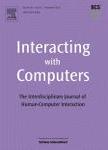版权所有:内蒙古大学图书馆 技术提供:维普资讯• 智图
内蒙古自治区呼和浩特市赛罕区大学西街235号 邮编: 010021

作者机构:Univ Geneva Swiss Ctr Affect Sci CH-1202 Geneva Switzerland Aerosp Med Flight Physiol German Aerosp Ctr D-51147 Cologne Germany
出 版 物:《INTERACTING WITH COMPUTERS》 (与计算机相互作用)
年 卷 期:2015年第27卷第5期
页 面:534-550页
核心收录:
学科分类:1201[管理学-管理科学与工程(可授管理学、工学学位)] 08[工学] 0812[工学-计算机科学与技术(可授工学、理学学位)]
主 题:Collaborative interaction Collaborative and social computing Human-centered computing Law social en behavioral sciences Affective computing Physiological computing
摘 要:Physiological and affective computing propose methods to improve human-machine interactions by adapting machines to the users states. Recently, social signal processing (SSP) has proposed to apply similar methods to human-human interactions with the hope of better understanding and modeling social interactions. Most of the social signals employed are facial expressions, body movements and speech, but studies using physiological signals remain scarce. In this paper, we motivate the use of physiological signals in the context of social interactions. Specifically, we review studies which have investigated the relationship between various physiological indices and social interactions. We then propose two main directions to apply physiological SSP: using physiological signals of individual users as new social cues displayed in the group and using inter-user physiology to measure properties of the interactions such as conflict and social presence. We conclude that physiological measures have the potential to enhance social interactions and to connect people.